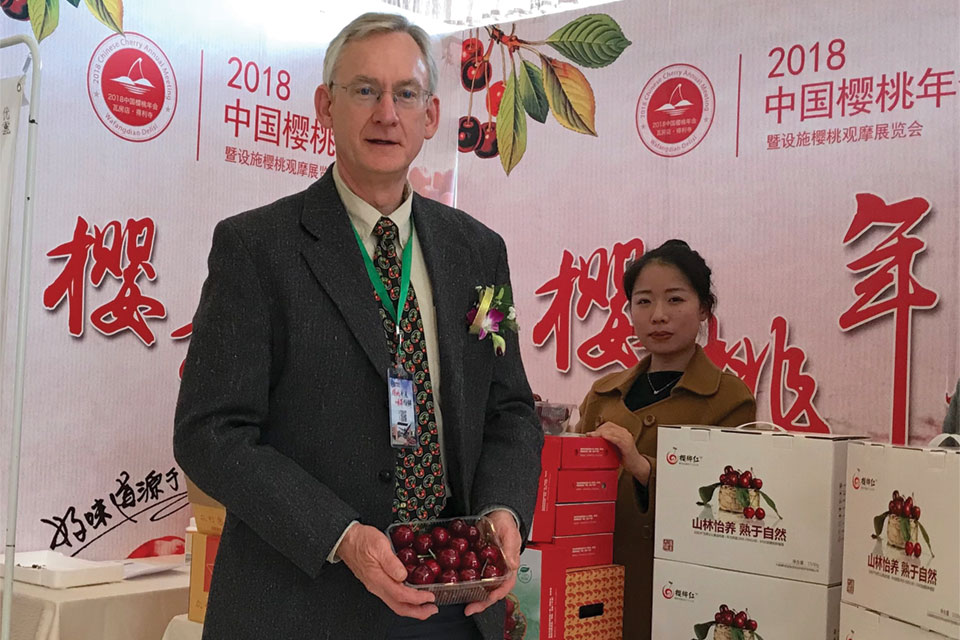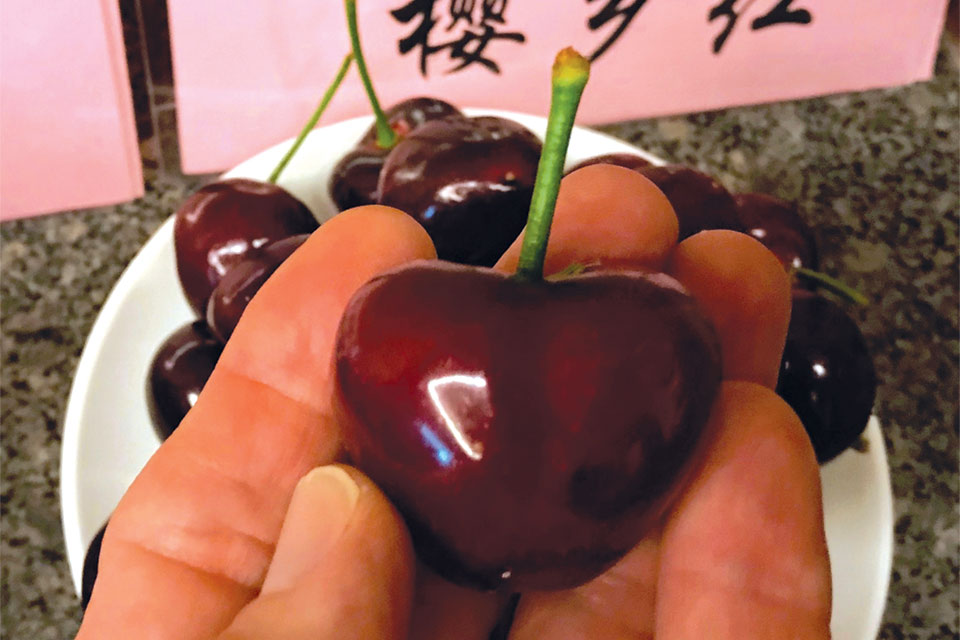China’s Effect on World Cherry Production

Figure 1: A half-greenhouse with cherries in Liaoning, China. (Photo: Greg Lang)
In 2017, I was fortunate enough to be asked to give the plenary address at the eighth ISHS (International Society for Horticultural Science) Cherry Symposium in Yamagata, Japan. I began by briefly discussing world cherry production, using data from the 2016 World Sweet Cherry Review by Des O’Rourke, an excellent overview and analysis of world sweet cherry production and marketing trends. This entailed charting worldwide production trends since the fourth ISHS Cherry Symposium, held in Oregon and Washington (2001), a time that coincided with the commercial availability of the Gisela series of precocious, vigor-controlling rootstocks becoming more widespread in North America and Europe.
During those 16 years between Symposia, world sweet cherry production has increased by 52%. In 2001, Turkey was the leading producer and was still No. 1 in 2016, with a production increase of 120%. The No. 2 producer had been Iran, but production declined during that time by 9%, bumping Iran to No. 4 worldwide in 2016. The U.S. was the No. 3 in 2001, but has increased production by 72%, taking over the No. 2 worldwide position for the past 10 years. The fourth and fifth highest-producing countries, Italy and Spain, increased by 16% and decreased by 12%, respectively, falling to No. 6 and No. 7.
The biggest worldwide production changes since the turn of the century, though, were closely related to each other. Chile, which was a very minor producer in 2001, increased production by an amazing 363% by 2016, becoming the fifth-largest producing country. Furthermore, Chile surpassed the U.S. in 2015 for No. 1 in sweet cherry export volume and value, and actually doubled that export production figure by 2017-18 (probably passing Iran to become No. 4 in overall production).

Figure 2: Cherry trees inside a Chinese half-greenhouse. (Photo: Greg Lang)
China Makes Its Mark
The primary market destination(s) for this massive quantity of exported Chilean fruit? One country — China. This past year, Chile provided 82% of the sweet cherries imported into China for their rapidly growing middle class; this was 86% of Chile’s cherry production!
On a similar trajectory is China’s domestic sweet cherry production. Though accurate production figures have been difficult to verify, China was a minor producer at the turn of the century. However, by 2016, the available production figures showed an increase of 1,848%, moving China into No. 3 on the worldwide production list. At the Symposium in Japan, one of the leading Chinese cherry scientists told me that my data significantly underestimated production.
Chinese cherry production could, in fact, be as much as three times higher than what I listed. Consequently, this past March, I was invited to give the keynote address at China’s national cherry conference in Dalian. Indeed, I saw figures presented there that indicated China’s production may be only slightly less than that of Turkey and the U.S. combined.

Figure 3: Helping display some greenhouse-grown ‘Tieton’ cherries in Dalian, China, ripe on March 19. (Photo: Greg Lang)
Reflecting on this, my first visit to several of China’s cherry producing areas was in 2010. A number of things struck me on that, and two subsequent, trips. Production was mainly with large trees, of old local
varieties (such as ‘Red Lantern’), in orchards of less than an acre, usually with no irrigation, minimal pruning, and training (when attempted at all) was often accomplished by tying large rocks to branches to pull them down to more horizontal orientations. Rural roads were rough, and postharvest technologies were almost non-existent, including refrigeration.
High Density Comes to China
There were also some newer, larger orchard operations, at high densities, with irrigation, and with more international varieties, like ‘Brooks.’ In fact, I was proudly shown a nursery with fields of 100,000 Gisela 5 rootstocks, as well as a nursery with “tens of thousands” of ‘Tieton’ trees (since I had named and released ‘Tieton’ in the late 1990s when I was at Washington State University).
The irony of showing me many acres of these two patented plant materials was lost on my hosts at the time. Certainly, that intensive nursery production has now found its way into many more new, more modern orchards. However, most orchards are still often more labor-intensive than precision-intensive.

Figure 4: A greenhouse-grown ‘Tieton’ cherry in Dalian, China, probably weighing about 25 grams. (Photo: Greg Lang)
A further irony occurred at the Japan symposium and the Dalian conference. I was told in Japan that ‘Tieton’ had become the No. 1 cherry variety for new orchards in China, and in Dalian, I was told that it was the No. 1 variety for greenhouse production. In the Dalian area, I saw hundreds of typical “half-hoop” Chinese greenhouses (see Figs. 1-2) and learned there are more than 1,000 hectares (2,500 acres) of sweet cherries now being grown in greenhouses to fill the market gap between late southern hemisphere cherries and early northern hemisphere cherries. Indeed, during the third week of March, there were impressive
displays of extremely large, ripe ‘Tieton’ fruits (see Figs. 3-4). Most of those that I saw firsthand are produced with the growth regulator Cultar to limit vigor, along with extensive pinching and flower/fruit thinning by hand to achieve the very large fruits that bring very high prices.
In Chinese culture, sweet cherries are highly appreciated as gifts, being associated with good fortune, prosperity, respect, and affection for loved ones. This, of course, is in addition to simply being a wonderful, intensely-flavored eating experience — as enjoyed elsewhere in the world. It will be interesting to see how much this production continues to develop, and impact world sweet cherry markets and producers, between now and 2021, when the ninth ISHS Cherry Symposium will be held, of course, in China!










